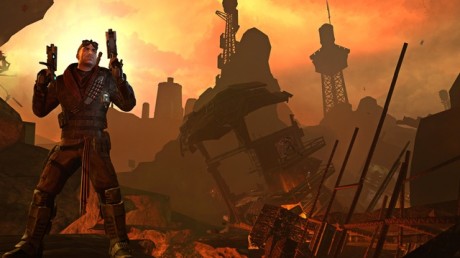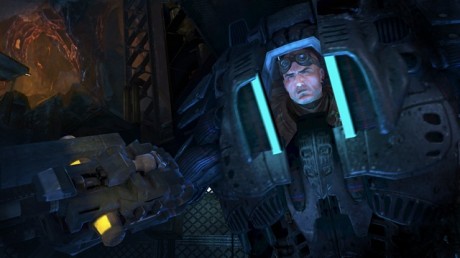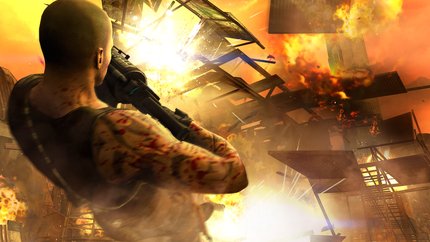We go underground on the Red Planet in the sequel to 2009′s Red Faction: Guerrilla.

In Red Faction: Armageddon we are on Mars with a shaven-headed Mason once again: Darius Mason this time, grandson of Alex, hero of 2009′s Red Faction: Guerrilla. But where Guerrilla had us rove around on the Martian surface, Armageddon takes us underground. Terraforming has failed since the events of the last game, making Mars uninhabitable aboveground, forcing the human population to relocate into deep networks of rocky caverns. And where Guerrilla was open-world, Armageddon is basically linear, though with some larger, open areas suitable for sandbox-style play linked by the game’s subterranean roads and corridors.
The game’s producer, Jim Boone, tells us Armageddon’s linearity comes from player feedback. Though fans of the previous game enjoyed the vehicles and free-form destruction, he says, they were less keen on trundling long distances through an open environment. He also tells us that some 20 percent of the third-person action still takes place topside, though we didn’t see any sky for the few-hour duration of our hands-on demo, which was taken from early in the game.
As the demo began, the humans were already besieged by huge and vicious insectile beasties. Since these came from deep within the planet Mars and the humans from planet Earth, they are technically the natives. For the purposes of this preview, however, and because they are huge and vicious insectile beasties, we shall call them aliens. Our hero Darius is somehow to blame for the alien uprising–but inadvertently, mind you, and doing his best to make up for it. In the course of the demo, he escorts a convoy through hostile territory, fetches power cells and fixes water pumps for beleaguered civilians, and demolishes all manner of alien-infested structures.

Among the enemies are various brightly coloured red and green creatures, accessorised with organic blades and spikes and ranged bioweapon fire–glowing green globs that explode just after impact. We encountered plenty of ravagers: fast-moving, wall-climbing aliens with bone-bladed arms. Another alien creature, a stealthy variant, is invisible except when attacking but signals its proximity with a blurring effect on Darius’ vision. Others are less subtle and less buglike: one creature was a hulking, horned biped, like a Martian minotaur.
We weren’t short of hardware to see off the alien hordes, with Armageddon forever dropping new weapons in our path, but chief among them was the tremendously fun magnet gun. With this, the game’s signature weapon, you shoot item A (say, the side of a building) and then shoot item B (say, a spiky ravager) to fling the one into the other, as if by magnetic attraction. The quick two-shot operation works a bit like Dead Space’s kinesis module, letting you smash large chunks of the level furniture–girders, walkways, shacks, and the like–into your squishable foes, but also letting you launch enemies up and away, by firing at them and then at the distant cavern ceiling.
The magnet gun is also useful for demolition purposes. Alien-infected buildings can be destroyed by “magnetising” the roof and the floor, or one wall and the other, making it crumple up with zero ammo expenditure. Another demolition option is the powerful, no-mess nano-rifle: a gun that simply dissolves objects and enemies, with none of the gooey splatter of swatting an alien with a corrugated iron shack.
The extensive destruction will be familiar to players of Red Faction: Guerrilla. (Once again, terrain can’t be deformed, except for the odd rocky crystal structure, though most man-made structures are fair game.) But Armageddon balances the large-scale demolition with the addition of a repair ability. Darius is equipped with a nano-forge, which is a kind of multi-tool with a number of unlockable and upgradeable abilities, such as shockwave, which freezes and levitates foes close to you; beserk, a double-damage buff; shield; and repair. This last ability is the inverse of the nano-rifle’s disintegrating ray. Like an all-powerful undo button, the repair ability conjures anything you’ve annihilated back into being; you can rebuild walls around you when you’re short on cover or reform a stairway while you climb it. Watching buildings rematerialise in a shimmery nano-glow is an unexpected treat.
For remote rather than up-close repairs, Darius has repair grenades, which can be tossed at distant ruined targets to remake them. These are also found in Infestation mode, the game’s Horde-style multiplayer mode, in which four players fend of waves of aliens. In Infestation mode, the repair grenades are especially useful for salvaging cover out of the destruction wrought by four magnet guns.
For anyone who played Guerrilla and did enjoy the open-world roaming, there’s no escaping the linearity of Armageddon. There was even a disheartening bit of backtracking through tunnels in the stretch we played. The largest caverns, though, do provide arenas for sandbox-style play. Hopefully, as vehicles are introduced–we saw little of these in our hands-on–the arenas grow too, with more room to manoeuvre and more sandbox opportunities to exploit. Fingers crossed also that the jittery frame rate on screens crowded by extravagant use of the magnet gun turns out to be a rarity.
Otherwise, Armageddon promises a fun third-person action game with enough novelty to make it interesting. A rugged protagonist against aliens on Mars is hardly fresh new territory–even discounting Red Faction titles–but Red Faction: Armageddon has an edge in its powerful magnet gun, free-form destruction, and magical repair tool. Look out for it this summer.
